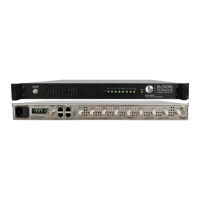
Do you have a question about the Blonder tongue AQT8 Series and is the answer not in the manual?
| Brand | Blonder tongue |
|---|---|
| Model | AQT8 Series |
| Category | Transcoder |
| Language | English |
Details revisions made to the manual over time.
Describes the unit's intended use and key functionalities.
Lists detailed technical parameters for inputs, outputs, and general specs.
Lists the items included in the product package.
Guides on rack mounting and powering on the equipment.
Configures network access for unit control via web browser.
Explains how to connect and log into the unit's web interface.
Displays key operational parameters like status, temperature, and uptime.
Reports any detected problems or errors with the unit.
Shows the status and signal-to-noise ratio for RF inputs.
Displays link speed, usage, and assigned IP/port for IP outputs.
Shows RF channel and frequency for each RF output.
Provides serial number, software, and firmware versions.
Configures transport streams by selecting programs and their parameters.
Guides on how to add programs to selected transport streams.
Explains how to remove programs from configured transport streams.
Details search and control functions for managing TS programs.
Sets basic parameters like bitrate, TSID, and channel mapping for TS outputs.
Configures advanced parameters including PID mapping and QAM status.
Filters and views transport streams assigned to outputs.
Allows offsetting PIDs relative to the Program Map Table.
Selects two 8VSB transports for merging into a single stream.
Configures parameters for the multiplexed transport streams.
Configures destination IP, port, and TTL for IP output streams.
Selects and assigns available transport streams to IP outputs.
Displays remaining transport streams and bandwidth for IP output.
Provides options to remove configured IP output streams.
Offers search and filter functions for managing transport streams.
Sets global parameters for RF output level, mode, and channel map.
Configures system time, timezone, and NTP synchronization.
Views system log messages and filters event types.
Manages firmware updates and checks current version.
Configures network settings, unit identification, and saves/loads configurations.
Allows changing of username and password for unit access.
Outlines the terms and conditions for the extended warranty agreement.
